|
FAQs about Zoanthid Compatibility, Control
2
Related Articles: Zoanthids, Sea Mat: An
Ocean Of Color For The Aquarium by Blane Perun,
Related FAQs: Zoanthid Compatibility/Control 1,
Zoanthid Comp./Control 3, Zoanthid Comp./Control 4, &
Cnidarian
Compatibility, Zoanthids, Zoanthids 2, Zoanthids 3, Zoanthid ID, Zoanthid Behavior, Zoanthid Selection, Zoanthid System, Zoanthid Lighting, Zoanthid Feeding, Zoanthid Health, Zoanthid Reproduction,
|
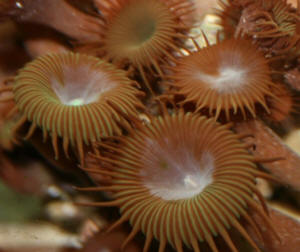 |
|
All my Zoanthids are closed! 2/28/10
Hi,
<Howdy>
Having searched all through WWM and other forums for help with my
problem, I have had no success. All of the Zoanthids in my system
are closed, and the have been for over 3 months.
<Summat's up>
I have done a hydrogen peroxide dip and a freshwater dip on all
of them (I have about 6 different kinds...) over about the past
month or so and there is still no change. The hydrogen peroxide
dip did seem to get rid of some fungus
<?>
on some of them, but the freshwater dip cleaned off nothing but a
few small pods and some snails (not sundial though). I have
looked at all times of the day and night and have yet to find one
Zoanthid spider, sundial snail, or Nudibranch on any one of my
colonies. Also, the Zoanthids are not 'melting away', and
some of them still look very plump.
My system is very small, 10g with a 5g refugium of Chaeto. I know
there might be a problem with allelopathy among the
Zoanthids,
<Ah yes... likely in/with such a small volume
especially>
but wouldn't one of the colonies be thriving while the others
are closed off?
<Mmm, nope. All could be, are apparently
"losing">
Also, there is only a crocea clam, and two small xenia and clove
polyp frags <Either one of these could be
"winners">
in there with them, each of which is thriving. There is only one
fish in there right now, a yellow watchman,
<Needs more room than this>
and some Turbos and Astreas. The only other thing I can think of
is that my lights may be old, I am running a 70w MH unit about 8
inches above the water and the bulb is about 8 months old... it
is a good bulb though and like I said this has been going on for
months so I doubt this is it. My water parameters are good,
too:
SG 1.024
<S/b higher. See WWM>
Ammonia 0
Nitrite 0
Nitrate 0
<An essential nutrient. Could be the trouble here>
Phosphate 0
<Ditto. Remove, reduce your chemical filtration, increase
feeding>
Ca 1350
<Mmm, no>
dKH 9-10
Mg 1525 (I know a bit high... but I doubt this would do it?)
<Yes, could>
Temp: 78-81
Lighting: 70W MH for 7hrs, actinic 2x18W 9 hrs
Flow: 2 90gph pumps, 1 Koralia Nano
I also have My tank has been up and running for over two years
now and I have been able to keep Zoanthids fine until about 3-4
months ago. Attached are some photos of my closed colonies. I am
at my wits end and ready to throw my tank out. I know Zoanthids
can be finicky, but I would think at least one or two colonies
should open. Any ideas?
<... fix your water quality first, do what is necessary to
provide some NO3, HPO4... Move the colonies elsewhere... Bob
Fenner>
|
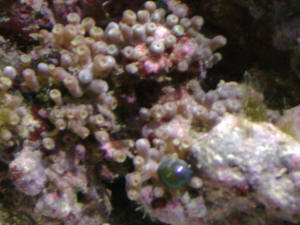 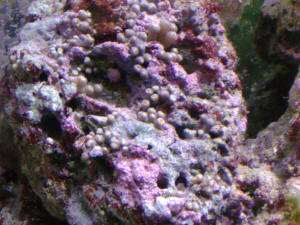 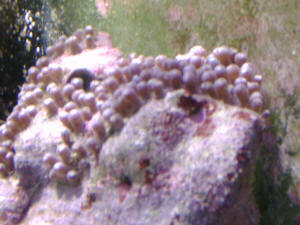 |
|
Re: All my Zoanthids are closed! 2/28/10
Thanks for the quick reply. I think I will move the bigger
colonies to the LFS and be content with Xenia/clove
polyp/clam...
<Ahh>
leave one or two small Zoa frags, and try to get the water
quality right.
<Good>
The problem with Nitrate and Phosphate is that even when I feed a
lot they are still undetectable, I assume due to my Chaeto in my
"refugium" which grows quickly.
<I would keep harvesting this Green Algae; to the extent where
there is some measurable essential nutrients here>
However they must be in there somewhat because I still have
significant green hair algae.
<Oh! Then address this first. See WWM...>
Could it be a problem with ph/alkalinity swings?
<Yes>
I add Kent SuperBuffer regularly
<S/b only done through additions to pre-mixed, stored new
water during change-outs>
but there could still be swings and this I have heard to affect
Zoanthids. Or are you pretty sure it is allelopathy?
<Can't discern from here>
I am pretty resigned to the fact that this is it. Again thanks a
lot for the service.
<Certainly welcome. BobF>
|
Coral Compatibility/Allelopathy
1/14/10
<Hello Nikki>
Hello I have a question. I have lots of Zoanthids in my tank, and
recently purchased a Bubble Coral. Will they be okay if they touch each
other?
<Euphylliids, of which the Bubble Coral is a member, possess very
expansive bodies and stinging tentacles which can/will extend to other
sessile invertebrates placed near them. And, there is a good chance of
negative chemical interaction with Soft Corals. I would leave at least
six inches of space between this coral and any other corals including
Zoanthids.>
Thanks.
<You're welcome. James (Salty Dog)>
Zoa placement re others 12/7/09
Salutations to the Crew!
<Howdy Rich!>
Firstly, I have only found it necessary to write in infrequently due to
the vast wealth of information on your site - and the obvious
dedication of the Crew themselves. The previous information regarding
my algae problems kept me in the hobby. Keep it up the great work.
<Am trying>
I have read a fair bit regarding the Zoanthids/Palys, learned a lot,
but have yet to find info regarding placement with a feather
duster.
Specifically, can the polyps come in contact with the tube of a
Hawaiian feather duster or is this on the list of 'don't
do'?
<Mmm, I don't know of any real trouble, negative interaction
twixt the two.
Have seen these disparate groups in close contact at times in the
wild>
Eagerly awaiting my wake-up call... and thank you again.
Richard J.C.
<Cheers, Bob Fenner>
Killing Palys. Zoanthid control, human toxicity
f's-- 12/04/09
Dear Crew,
<Glenn>
I have a tank being over run by brown polyps. I believe people here
call them Texas Trash Palys. At first it looked nice to have a large
mat of these but this is getting ridiculous. They were growing on all
the rock, sand and back wall. Now I have reason to believe they are
making me ill.
<No bueno!>
8 weeks ago, I did a lot of work on my tank, mainly removing algae and
removing Palys growing on the sandbed. So my hands were in the water. I
was wearing gloves, but they only come up above my wrists. I don't
remember having any cuts. That night, I had trouble sleeping due to
chills. I got up and went into the bathroom and blacked out. Busted my
head open and bruised my ribs in the process. Went to the hospital but
had no fever. My lower BP# was initially really low. Recovered an moved
on.
A few weeks ago, I discovered a leak in my sump. So I broke down my
tank and put all the live rock, including Palys in totes. That night, I
had chills again and felt dizzy when I stood up. This time I sat down
and did not black out. I recovered later in the day. I got a new DT and
setup the new tank and sump. Put the LR and Palys back in. The water
smelled terrible. All my Ricordea were dead but the Palys were alive.
The can with the fish had a few rocks with Palys. Two fish were dead
and the others were near death. That night I got the chills again. My
remaining fish were dead by morning.
<Bad, bad and worse>
I'm thinking all of this is from the Palys.
<Could be>
Even if their not the cause, I want to get rid of them anyway. They are
reduced in number, but I'm sure they'll be back. My tank
completed a cycle and I've started adding some hermits and a
brittle star to clean up anything left decaying in there. I as hoping
to begin restocking fish this weekend. How can I kill the Palys and not
have another cycle of the tank?
<Remove all rock with them, the Zoanthids on them... Bleach... for a
day... Rinse, let the "old" rock air dry... for a few days...
Place back in the system with some new atop to reseed with other forms
of life>
Not to mention avoid taking the rock out of the tank and manually
removing them?
<This is what is necessary... Either that or nuking/bleaching all in
place.
Yes, I am serious. You are by far not the first or worst to be
malaffected by these Sea Mats... Do take care. Bob Fenner>
Thanks,
Glenn
|
Corals <Zoanthids> Gone Wild! (Polyp Invasion)
-- 11/10/09
Hi Crew,
<<Hiya Lynne>>
I have attached a picture of my aquarium showing how some coral
polyps I bought in the past have totally taken over my live rock
in my tank.
<<Yeeikes! I'll say they have!>>
I have tried keeping the live rock pieces separated in the tank
but when I clean the tank pieces break off and eventually find an
open piece of live rock and start growing.
<<Indeed>>
It's not the worst problem in the world
<<Uh, yeah'¦as long as you don't want to
keep any other type/species of coral>>
but is there any way I can obliterate this coral from my
tank?
<<Not without some collateral damage>>
Any fish or invertebrate that will eat it?
<<Some Butterfly and Angel species 'might' take a
shine to these polyps (a bit of research will reveal which ones
naturally feed upon corals/polyps as opposed to those that feed
upon sponges/tunicates, in the wild), but finding one that does
will likely put any other 'desirable' corals or polyps
present, in danger as well. I have also seen Foxface Rabbitfish
that would decimate polyp colonies'¦but not all behave
in this manner. Probably one of the more likely fish to go after
these polyps, in my experience, would be Heniochus acuminatus
(Not to be confused with the similar looking and 'more
reef-safe' H. diphreutes). In most every instance that I can
recall, H. acuminatus, though largely planktivores have gone
after Zoanthids/polyps in a closed system with
relish'¦but still, this is no guarantee. I once had a
problem with a metallic green Palythoa that began as an
incidental introduction and quickly resulted in a growing
infestation. It is remarkable how 'durable' these
creatures are when eradication is desired. I tried everything
from Kalkwasser to straight Lugol's Iodine injections. The
polyps would ball-up for a bit after these treatments, but always
came back and continued to thrive'¦and to kill/grow
into/over my Acropora corals (So, save yourself the expense,
trouble, and danger to other tank inhabitants re trying to
'poison' these unwanted intruders). In the end it came
down to sacrificing some live rock by removing 'any'
infested rock and letting it dry out completely. Looking at the
extent of your polyp invasion, I fear you may be in the same boat
here as I was>>
Thanks,
Lynne
<<Happy to share'¦ EricR>>
|
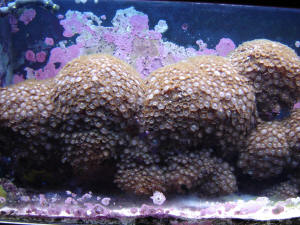 |
|
Re: Corals Gone Wild! (Polyp Invasion) --
11/11/09
Hi Eric,
<<Hi Lynne>>
Thanks for your time.
<<Quite welcome>>
What would be the procedure to "kill" the corals off of
the live rock without losing the live rock?
<<As previously stated, in my experience these organisms
are surprisingly resilient and resistant to any poisoning that
wouldn't also be hazardous to your rock/tank in
general'¦especially so considering the extent of the
growth/coverage on the rocks shown in your earlier photo. Part of
the problem also stems from the fact that the polyps themselves
are quite toxic and even should you move the rock to a treatment
tank, if the 'poison' used (Kalk paste, Lugol's,
etc.) doesn't get it, the degeneration/disintegration of the
polyps alone can kill the other biota in and on the rock.
You're best option here is to discard/replace these rocks
altogether. If that is not possible, then I think your next best
option is to 'manually' remove the polyps from the
affected rock. For this to work you will have to remove
'every little speck' of the organism from the rock. The
best way to do this is to 'shave' the polyps from the
rock with a sharp carpenter's chisel (a cheap one from any
hardware/department/home store will work fine). The process
involves removing a thin layer of the soft carbonaceous rock
under the attachment point/s of the polyps. Please be aware this
method is not without RISK OF SERIOUS INJURY should you push the
chisel in to your hand or some other part of your body.
Precautions must also be taken to avoid any skin contact with the
polyps, as the previous mentioned toxin is also dangerous to
'you' (be VERY mindful of not scratching any itches!)
Both during this process and afterwards before placing back in
the display, the rock should be rinsed in clean saltwater. And of
course everything else (your hands/tools/bowls, etc.) will also
need a good washing>>
Lynne
<<I do think you should reconsider trying to 'save'
the live rock'¦much more hassle/danger involved than
it is worth. Abundans cautela non nocet'¦ Eric
Russell>>
R2: Corals Gone Wild! (Polyp Invasion) --
11/11/09
Thanks Eric!
<<Happy to share! EricR>>
|
|
Inquiry re: Heliacus Snails as predators of Zoanthids
11/11/09
Hello Crew,
<Lynn>
I have Zoanthids that have grown wild in my tank and I want to
remove them.
I've read on your site that the Heliacus snail is a predator
of zoos.
<This is so>
Do you think that putting a large quantity of these snails in my
tank will kill off the Zoanthids? If so, where can I buy these
types of snails?
<Mmm, I'd enquire of etailers, your local fish stores that
deal in reef/marines, and even online directories like
Craig's List re... it may well be that some hobbyists have
them that want to rid themselves of them>
If these types of snails are not for sale, is there a snail or
Nudibranch I can purchase that will eat the zoos?
<Not reliably, no... and...>
See attached photo of my overgrown Zoanthids.
Lynne
<Do take extreme care if handling these Cnidarians... are very
toxic. DO read here:
http://wetwebmedia.com/zoanthidcompfaqs.htm
and the linked files above re. Cheers, Bob Fenner>
|
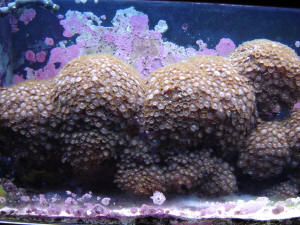 |
Coral Attack, Zoas vs. Decapods
9/16/09
Need more help.
<I know I do>
I have a 135 with 150lbs of live rock. Nice and purple. Nitrate is less
than 10 and on its way down, as I just installed a RDSB. I found a
single Zoanthid growing on the rock and figured it was a good time to
put a few test corals in. I put in a small frag with about 10
Zoanthids. The Zoa's were attached to the skeletal remains of
something. It was not a rock. The first night one of the hitchhiker
crabs apparently removed the coral from their attachment and took the
structure away.
<Wow; strong crabs>
I found the Zoa's on the bottom curled into a ball. I have replaced
them in another location and they are slowly moving up the rock.
Is any of this normal? Will the Zoa's recover?
<Mmm, hopefully. You might want to rig some sort of strong cover
over them for now. Maybe a plastic "berry" container,
inverted, tied down with all-plastic ties.>
I have seen 3 crabs. Based on their claw configurations, 2 need to
go.
The last time I tried trapping, nothing happened. I assume crabs do not
hunt during molting?
<For the most part this is so>
I found sheds during the time I tried the trap.
I really appreciate all the great information on the site and in the
Bob's books. The entire family is having a great time learning and
watching new things happen every day.
<Ahh, great! BobF>
Thanks,
Erik C. Hayes
Xenia / Zoanthids: Natural Ways To Prevent
Spreading 9/9/09
Hello WetWeb Crew!
<Hi Jeff>
I'm planning out a 90 gallon softies reef and would like to
concentrate on Zoanthids and pulsing xenias. I have 2 rock clusters on
either side of the tank, one of which will be devoted to the Zoas and
the other for the xenias. Assuming that both corals are able to thrive,
I'm concerned that they will both spread prolifically leading to
significant maintenance. I'd like to find a natural way to limit
the growth (especially on the xenias),
and one idea would be to introduce a leather coral in between the two.
If the xenias spread to the leather's turf, the leather would
protect its territory by stinging. Would this work and is it a good
idea? If so, what
are some specific species recommendations?
<Not a good idea with the leather. Xenia's form a colony, all
attached to each other, and a sting will likely affect the entire
colony. I've tried an experiment to control a colony of coral by
placing an aggressive coral near the colony. The end result, which took
a few weeks, was the decimation of the entire colony. I suggest you
keep these corals on a rock the size you wish the colony to be. Any
corals spreading from the rock
can easily be controlled by cutting.>
Thanks a bunch!
<You're welcome. James (Salty Dog)>
Tanks equip (not yet setup!):
90 gallon, w/ 4 inch DSB
30 gallon, 3 compartment sump with mud refugium (reverse daylight
lighting)
Current USA Nova Extreme Pro 6x54 watts T5
Vortech MP40
ASM G-2 Skimmer
Planned Fish:
2 Ocellaris Clowns
1 Royal Gramma
1 Canary Wrasse
1 Radiant Wrasse
<Not entirely reef safe.>
1 Neon Goby
1 Cherub Angel
<Not one of the easier pygmies to keep if you are new at this. A
Coral Beauty would be a better choice, keeping in mind that they are
reef safe, but with caution.>
<<Really James? I find that Centropyge argi is much hardier on
average in semi-peaceful settings. RMF>>
Jeff
Zo Polyps encroaching on clam space
8/29/2009
Hello, I hope you are all okay.
<Very well thank you.>
My problem is that I have a beautiful Blue Clam attached to a big
rock.
Time ago I had some Zoanthid Polyps a good distance away. Now the
polyps reproduced and got big and are starting to cover the rock and
are in contact with the Clam. I don't see any damage to the Clam
yet but I'm worried. What can I do? Do I have to remove the Polyps?
How? The Clam is really attached so I think I can't remove it.
<I would recommend trying to fragment the rock in such a way to
separate the Zoanthids and the clam. If that does not seem possible the
next step I would take would be to eradicate some of the Zoanthids that
are closest to the clam. Of course this wouldn't really fix the
problem only delay it.>
Also Xenia is now in contact with some Leather Coral. When that happens
and can't move because are attached to the same rock what's the
procedure?
<Once again, I would try to fragment the rock and separate the
corals.
This is a common problem in "reef garden" type aquariums. All
the animals are competing for space, if left long enough uninterrupted
the whole tank would likely be full of just one or two species.>
Thanks and sorry for my bad English!!
<You did better than most English speaking people.>
Fernando Muscolo
<Josh Solomon.>
|
Zoanthids Disappearing, Hitchhiking Crabs --
7/18/09
<Hello Jared, Lynn here this afternoon.>
I have been loosing the expensive Zoas fairly fast each
night.
<Yikes! Have you looked for the usual suspects? Please see the
following links for more information/photos:
http://www.zoaid.com/gallery2/main.php?g2_itemId=384
http://www.zoaid.com/index.php?name=FAQ&id_cat=3#q15
http://www.wetwebmedia.com/zoanthidcompfaqs.htm >
The ugly cheap ones are doing great just like kudzu (of
course).
<Murphy's law strikes again.>
I have lost a quite a few whole colonies of tubs blues, gorilla
nipples, fire and ice, black cherry and so on. In all about $300
of Zoas!!!!
<Yowza!>
I pulled out my trusty red lens light 3 nights in a row and found
this guy in a hole near the Zoas. Now I do not know if he is the
culprit, as he does not have the really fuzzy bear legs or sharp
claws on the ends (they are flat and look just like a emerald
crab)....so a rogue algae eater gone to the dark side
maybe????
<I don't think the crab was actually eating the Zoanthids,
but it's possible that his presence was acting as an
irritant. In which case, you'd have noticed the polyps
remaining closed for extended periods of time (not disappearing
overnight). I guess it's always possible that, for whatever
reason, the crab was pulling the polyps off the rock. I just
don't know. What you describe sounds more like deliberate
predation. I'd look for Nudibranchs, Heliacus/sundial snails,
and others listed at the above link. One other thing to do though
is check the remaining Zoanthids for any sign of small
light/whitish spots. If so, it could be what some hobbyists call
Zoanthid pox. Please see this link for a photo example:
http://www.zoaid.com/gallery2/main.php?g2_view=core.DownloadItem&g2_itemId=3573
For treatment, see first FAQ, titled 'Zoa Pox Treatment --
05/09/09' at this link:
http://www.wetwebmedia.com/furancpdfaqs.htm
More info here regarding diagnosis/treatment:
http://www.wetwebmedia.com/zoanthidhlthfaqs.htm >
Plus he lost a leg battling me.
<Oops!>
I accidentally skewered it with a bamboo skewer and was able to
force him out of the hole that way. I have him in my fuge with
easy access to remove him, but I have found 2 more EXACTLY like
him in another piece of base rock. And of course they are either
too far in or they scurry away before I can get them.
<No kidding. They know they can't win a battle against the
skewer-man!>
Zero damage as of yet from them, but I am still trying to get
them.
<I would do the same.>
He looks very similar to the header pic and last pic on:
http://www.wetwebmedia.com/Arthropoda/CrustaceanPIX/SWCrabs/Crab%20IDs/swcrabid12.htm
<Gotcha. Although those claw tips look fairly blunt, they
don't appear fully spatulate like those of
emerald/Mithraculus crabs. Also, the presence of hefty molar-like
('molariform') structures on the inside edges indicate
that the claws are less adapted for eating algae and more adapted
for crushing -- usually mollusks. Crabs on the whole are
omnivorous creatures. They're usually okay in reef tanks when
small, but can be a problem as they grow larger.>
What do you guys think????-- Trigger/octopus food or not?
<Well, the trigger and octopus would definitely love it, but
I'm a softie; I'd spare their lives and find them a new
home in the sump or elsewhere.>
Jared
<Take care, LynnZ>
|
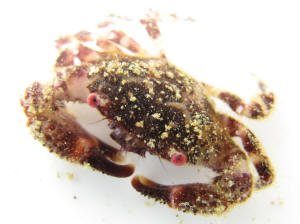 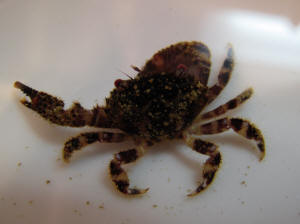 |
polyps on a clam 5/12/09
I purchased a frag of about 10 zoo. polyps 4-6 weeks ago, affixed them
fairly high on live rock, using glue. A friend of mine was over, and he
noticed that what we thought was a small rock the zoos were attached
to, is in fact what appears to be a small Tridacna clam-at best the
size of a quarter. Its been there without me realizing it, for about a
month.
<Interesting... likely another bivalve rather than a
Tridacnid>
My question is whether you would advise that I try to remove the zoos
and relocate them, in order to maximize the light that reaches the
clam.
<Yes I would... if you intend to try saving the clam's
life>
Thanks in advance,
Larry Marshall
<Welcome. Bob Fenner>
Coral and Clam Competing for Turf
5/5/09
WWM Crew:
<Josh Here>
I've been lucky enough to have the livestock in my reef tank
flourish, but now I fear that I'm running into an issue where I
have too many creatures competing for limited reef space. I've been
able to somewhat successfully deal with this problem in the past, but
now I'm in a bit of a pickle. I've attached a photo of my
problem area. Obviously everything is attached to the rock, so I
can't easily move anything. I'm most concerned about the clam
getting stung, and I don't really care about the mushrooms or
Zoanthids if they need to be removed.
<The clam may be getting close there... but they don't seem
quite as close as you make it sound. Anyway, it couldn't hurt to
separate them. While it certainly isn't ideal for the clam to be in
contact with the coral, do Google search some for some photographs of
giant clams in the wild, (often surrounded by corals).>
Will the clam survive if I allow it to be smothered by the Zoas and
Shrooms, and if not, what is the best way to remove the Zoas and
Shrooms. I'm afraid that scraping them away with razor blade will
release toxins into the water. Thanks in advance for your help.
<Should be fine to scrape, if this rock is like most live rock, it
may be just as easy to scrape away a layer of live rock with the corals
attached as to scrape the corals themselves.>
Sincerely,
Jesse
<Good luck with the coral relocation...
Josh Solomon>
Xenia and Zoanthid Control -- 5/1/09
Hi again,
<Hi Steve!>
Thanks so much for your help!!!
<You're welcome!>
Can I ask another question?
<Go for it>
Okay, I've got a whole lot of rock with Zoanthids and Xenia that
are taking over my tank.
<Uh-oh. That's a common problem -- especially with Xenia. I had
a similar issue with Green Star Polyps years ago. My tank looked like
the green hills of Ireland which was pretty, but not what I had in
mind!>
I want to get rid of these entirely, do you have any ideas?
<Yes. Option number one is to sell or swap the rocks with the Xenia
and Zoanthids on them. The saying 'One man's weed is another
man's wildflower' applies here. Check your local fish club,
stores, or other hobbyists in the area. Xenia is a poor shipper so you
might be able to get a pretty good deal. Also, if you've got some
nice Zo's, those should sweeten the deal as well.>
I know I could scrub, but with all the holes, I would probably miss
some, and this headache would begin again in time. Is my only option to
set the rock in the sun for a few days, killing everything beneficial
on it?
<I wouldn't do anything that drastic.>
Or should I boil the rock?
<Nah>
I would like to rid myself of these weeds, before adding the new
rock.
<I can certainly understand that. If you don't want to swap,
frag (for sale) or outright sell the rock (and buy new) you're
going to have to get hands on with the stuff. One recommendation for
thinning Xenia is to take a sharp pair of scissors and cut each stalk
off at the base. If you want to take things a step further, you can
snip the stalks, then turn the rock(s) upside down away from the light.
For more information/methods (again, this problem is pretty common),
see the FAQ's at this link:
http://www.wetwebmedia.com/xeniidcompfaqs.htm . Regarding Zoanthid
removal techniques, this has been covered as well at WWM. Please see
the information at the following link:
http://www.wetwebmedia.com/zoanthidcompfaqs.htm . Just keep in mind
that these can be very toxic, so be careful -- wear gloves and
protective eyewear and don't let any children, pets, or anyone else
come into contact with them. For more information on Palytoxin issues,
please see this link: http://www.wetwebmedia.com/zoanthidreprfaqs.htm
>
Thanks again!
Steve
<You're welcome again! Take care, LynnZ>
|
Button polyps, beh., hlth.
1/26/09 Hi. I am new to saltwater and tried to look
through the forum to find my answers before emailing but
didn't quite see the same problem that I have going on. If it
was there and I missed, I apologize. I bought some button polyps
from my local fish store. After about 3 weeks in my tank, they
started getting this white film on some of the polyps; I attached
a picture. The colony seems very healthy but I was hoping that
this isn't some kind of fungus or disease starting. Could you
please tell me what this is? <Mmm, nothing appears too amiss
here... It often happens that Zoanthids (et al. similar sealife)
will "look different" being moved... conditions like
lighting, circulation being different, along with general stress
in being relocated> I have a 46 gallon that has been up and
running for about 6 months. I started with water, live rock, and
live sand form an existing aquarium so my tank cycled in a month
or so. I haven't had any problems with any other livestock
that is in my tank. My water parameters are: Salinity 1.022
<Mmm, this is too low... should be near natural seawater
strength... 1.025-1.026...> Nitrate maybe 5 but close to 0.
Nitrite 0 Hardness 400 Alkalinity 300 PH 8.4 Calcium 420 Iodine-
just did my first test and it read 0 but the reference water that
was sent with the kit was to be .06mg (ideal natural saltwater
according to the test kit parameters) and it read .01mg so I
don't know how reliable this new kit is. <Mmm, I2 comes
and goes... you should read a bit re its use in captive
systems... If anything, I'd dose during water changes...
"It" will generally read zero most all the time
otherwise> Any help would be greatly appreciated. Tammy
<There may be a bit of "allelopathy" going on here
with other Cnidarians... If your Zoanthids continue to further
whiten... I'd be reading here:
http://wetwebmedia.com/cnidcompppt.htm and the linked files
above. Bob Fenner>
|
|
|
Re: button polyps, beh./comp., hlth.
1/27/2009 Thank you for the reply. I will start to raise
the salinity and I'm glad at this time you don't see
anything wrong with the polyps. It's a colony of about 25 or
so and I really like them. I also read your article which was
very informative and helped. I only have a button polyp, 2 very
small star polyps, a small yellow polyp, and some Ricordea in my
tank very separated. Would there still be some allelopathy if
they are at least 5-10 inches from one another? <Could indeed,
yes... the organisms listed are not "very"
compatible... can/do mal-influence each other distally... through
chemical means> I have very good water flow thinking that
would help. I also have 2 sea fans that are separated from all
the other items if that matters. I tried to read up on everything
while I was buying to make sure I wasn't putting competitors
in but maybe I did.? <Happens...> Thanks again! Tammy
<Welcome my friend. Please do keep good notes, and inform us
in a month or so re progress here. BobF>
Re: button polyps, comp.
1/27/09 Thanks, I will. I thought I was doing good with
compatibility but as you say, it happens. Would an extra skimmer
or more water flow keep things moving around enough and clean the
water of the chemicals they put off? <Does help> I have a
SeaClone 100 skimmer, a maxi-jet 1200 power jet, and a Fluval
canister running... Should I get something else to help?
<Please read where you were first referred to... archived
below> I hope they all do ok and I will keep you posted.
Thanks again for all the information and the quick responses!
Great forum... I have read a lot of pages! Tammy <Ahh! Keep
moving forward. BobF>
Re: button polyps, comp.
1/29/09 I think I will get another skimmer like the one
I have to disperse the water. I will keep reading and studying so
I can do this correctly and don't lose things... Pretty
expensive hobby but I love it! Thanks again. Tammy <Welcome my
friend. BobF>
|
Re: Aquarium Planning: Zoanthidea Compatibility -
01/27/09 Dear Eric, <<Hello Frank>> I like to
thank you for your prompt and detailed response.
<<You?#8364;™re quite welcome>> You don't know
what it means to get an input from the experts when in doubt.
<<We?#8364;™re here to help ?#8364;you?#8364;? decide
what?#8364;™s best>> I carefully weighted your remarks and
most likely will go with a different type of corals,
<<Oh?>> possibly Ricordea and Rhodactis mushroom species.
<<Though less ?#8364;toxic?#8364;? than the Palythoa, the
Corallimorphs are not much less noxious (if at all), but do come in
some amazing colors and will make for a more attractive display in my
opinion. And not to discourage you but like Zoanthids, Ricordea species
can also be tricky to keep for novice aquarists>> I will need to
do more reading on the topic in the next few weeks to see how the
mushroom species will get along and how bad the allelopathy can be.
<<Indeed?#8364;? Reading/researching all you can is vital>>
It makes me wonder that people who are advocate of not performing
partial water changes frequently (or not at all) can end up with a soup
of different toxins and nasty substances in high concentration.
<<Agreed?#8364;? None of the filtration methods available today
can cleans the environment the way a simple water change
does?#8364;?along with its added benefit of renewing trace elements,
bio-minerals, et al>> Especially, if a variety of soft corals and
other species are kept together. <<Matters not?#8364;? ANY
aquarium should have the benefit of frequent partial water
changes>> One would think that such system should crash.
<<And likely they do>> Unless those molecule chains are not
very stable and break down to something else in time, or get absorbed
by other organisms and somehow remain in the system, or get exported
more effectively than we think via chemical filtration and skimming.
<<Unfortunately the volume and diversity of such organisms is
much too low to provide such a benefit as you describe, and the
chemical filtration and skimming does not collect all either. As the
saying goes...dilution is the solution to pollution>> That
remains a mystery to me. Another possibility is that those systems do
crash but the blame wrongfully goes to a secondary symptom. <<I
do think this is often the case>> I like to point out that WWM
turned out to be one of the best resources available.
<<Ah!>> When reading about a topic in the books, most
hobbyist literature (rightfully) repeat about 75% of the same
information and have about 25% or so of the content as new or
different. WWM on the other hand can be viewed as a database of case
studies. A hobbyist may find very specific information about a topic or
specie that is not available elsewhere. I thank you and your team for
keeping this database up and running. <<On behalf of Bob and the
rest of the WWM Crew, we are pleased to be of service>> Regards,
Frank <<Cheers mate?#8364;? EricR>>
Aquarium Planning: Zoanthidea Compatibility ?#8364;"
01/24/09 Hello to the WWM crew. <<And greetings to you
Frank>> First I like to thank you for providing such a valuable
source of information for the hobbyist. <<Ah, quite
welcome?#8364;?is quite the collective effort>> I have set up a
120g tank with no animals in it yet. Around 400 lbs of dried base rock
were cemented in the tank, then soaked and aged. <<Wow?#8364;?
Any room left for livestock to grow?#8364;?for fishes to swim?
[grin]>> Tank was cycled (seeded with one piece of live rock)
with lights off. <<Mmm, would have done this with lights-on
myself?#8364;?for the benefit of any photosynthetic organisms that came
with the live rock>> Ammonia was dosed on nightly basis to
facilitate the nitrogen cycle process. <<Okay>> To my
surprise, the only live organism that was visible on the live rock, a
small sea squirt, has tripled in size and I have a couple of yellow
pineapple shape sponges growing on the base rocks on various locations.
<<It is amazing what one can discover emerging from the live
rock?#8364;?in the absence of macro-predators. I think to many
hobbyists are in too big a hurry to stock their tanks to fully realize
this>> Lights are still off. <<Turning them on may well
bring forth more surprises from the rock>> At this time I am on
the last stage of the nitrogen cycle, waiting for the bacteria to
populate the sulfur denitrator filter. Meanwhile, I have enjoyed
reading and learning from a number of books and information available
on the web. <<Ah! Putting the time to good use then>>
However, the more I read and learn about the potential complexity of
keeping marine organisms together, the more I lean toward simplicity
for success in the long run. <<Assuming there is such a thing in
the hobby [grin]. But yes, mixing organisms from different oceans
and/or niches on the reef does indeed bring challenges?#8364;?but the
?#8364;mixed garden reef?#8364;? does still seem to be the
favorite?#8364;?and admittedly, is often most attractive>> I have
decided to keep a pair of Percula clowns (already in quarantine tank),
one royal gramma, and possibly a fourth fish for this set up.
<<Okay?#8364;? And is up to you, but you could do more
here>> Invertebrates will be a pair of yellow boxer shrimp
<<Neat>> (in quarantine) and one or two brittle stars. As
for corals, it has been a nightmare to select a mix for the long term
success. <<Aw mate, though not to be hastily done, this should be
the fun part. Have you considered a biotopic or species specific
display?>> To minimize physical and chemical competition, I
decided to select only one species for the entire system. <<Can
be quite dramatic>> I am not sure if this is reasonable or if I
am on the right track? <<Sure?#8364;? Though do also consider the
fishes that would associate with/occupy such a niche>> My first
pick is Protopalythoa sp. They are individual polyps (no connecting mat
tissue), and come in a variety of colorful choices offered on the
market. My plan is to purchase around 20 different types of Protopalys,
<<Hmm?#8364;? I didn?#8364;™t realize Protopalythoa was
available in such variety to hobbyists?#8364;?have only ever really
seen specimens in varying shades of brown or green. Now the smaller
Zoanthids are another matter re color selection/availability to the
hobby, but are somewhat more ?#8364;delicate?#8364;? than the Palys.
And do also realize that this probably won?#8364;™t be a
?#8364;species?#8364;? specific tank as I doubt there are 20
?#8364;varieties?#8364;? of a ?#8364;single species?#8364;? of
Protopalythoa available>> attach them to the rocks on different
locations, and let the nature do its job: no interventions.
<<Should prove most interesting>> I presume that within a
few months to a year the variety of polyps will get in close proximity
of each other and will be in physical contact. <<Indeed>>
My question is: 1) If different polyps will physically attack each
other or will they simply mix? <<I have heard claims that
Protopalythoa and Palythoa species will ?#8364;mingle?#8364;? with out
incident, but my own observations are that the individual polyps of
differing species that ?#8364;touched?#8364;? did not look happy about
it. Now, there is also a phenomenon called ?#8364;habituation?#8364;?
in which corals that normally wouldn?#8364;™t get along learn to
do so when ?#8364;growing up together?#8364;? in a captive
system?#8364;?but this is not guaranteed to occur. There is also
consideration that progressive generations of captive-propagated
corals; much like captive bred fishes, may lose some of their
aggression (or maybe just some of their ?#8364;ability?#8364;? to
inflict harm)>> 2) Should I worry about allelopathy? <<With
most any coral/sessile invertebrate/alga?#8364;?yes?#8364;?and
especially with the very noxious organisms you have chosen>> From
what I understand, Palythoa and Protopalythoa sp. contain potent toxins
harmful to humans and to the fish. <<And most anything
else>> 3) Is there a chance that the Protopalythoa polyps will
release any toxins in the water? <<Not a
?#8364;chance?#8364;??#8364;?is a certainty>> I have chemical and
foam fracturing filtration in place but not sure how effective they
will be. <<Very good?#8364;?and time will tell>> 4) Is
there a method to quantitatively measure the toxin contents of the
water? Or is there a method to detect them at all?
<<I?#8364;™m sure there is?#8364;? But nothing readily
available (or maybe even affordable) for hobbyists>> I hate to
rely on guess work if there are other options available. <<No
need to ?#8364;guess?#8364;??#8364;? Learning all you can about your
chosen animals along with frequent and close observation will help
much>> I am trying to conclude my planning and do need your
advice. Please elaborate on the potential success of this system.
<<I think you have a fine chance for success. These are generally
quite hardy and resilient organisms (can be impossible to eradicate in
systems where they are not wanted, in my experience). And
it?#8364;™s up to you, but for a more ?#8364;natural?#8364;?
presentation I would do more research re your fish selection for such a
display as this>> Best regards, Frank Amini <<Happy to
share. Eric Russell>>
Re: Post re: Derasa Clam, Zoanthid comp. 9/24/08
9/25/08 Hello all, I have a question in regards to this post
from Bob Fenner. Derasa Clam, hlth., comp. 9/24/08
Hello, this is my first question but I read your recommendations since
a long time ago. Sorry my English is not perfect. <I understand
you> My reef setup is running since a year and a half ago. Among
many corals and invertebrates I have these two clams since a year ago.
A derasa and I thing a Crocea, but I'm not sure about that. The two
clams where very good till now. The crocea is still very good but I see
the derasa not extending the mantle as before like 10 days ago. I try
to move the clam when I notice that the two shells were like
disassembled and feels like the top shell was going to fell. <Yikes,
no bueno> I leave the clam and not touched anymore. I was very
careful and I'm sure that I didn't do the damage. She opens a
little and the color is good and sometimes close and open a little but
I'm not sure if she can recover by herself. Is not getting worse at
least. I include a photo where you can see the two clams and you can
see that the top shell is like a couple millimeters off the natural
position. The water parameters are Ammonia 0 Nitrites 0 Nitrate 10
Phosphate 0 Carbonate hardness 8 Calcium 400 Temperature 80 I don't
have a chiller and its a 30 gallon tank 196 watts PC and the calms are
very high and in the center of the tank Thanks!!!! Fernando <I think
this animal is being poisoned by either the Zoanthid below or the Polyp
above. I would move either the clam or these stinging-celled colonies.
Bob Fenner> My question being, I have had a 3 inch maxima for about
5 months. When I bought it, I placed a shell underneath and let it
acclimate in the sandbed. <Good> The next day, it was attached
right in the middle of a Zoanthid colony that was nearby. <Mmm, not
good> I thought clams couldn't really be "stung" per
se, <Not so> so I left it. It's been a few months in this
location now, with no ill effects. I did notice that some Zoas have
attached to it's shell, but the clam still opens and shuts normally
to stimuli. Should I remove it, or be concerned here? <Ideally... I
would move it... and more. VERY important that you understand how toxic
Zoanthids are potentially... to you. If it were me, mine, I'd set
on a path either to leave all as is, OR arrange to remove the Zoanthids
from the shell... by taking the Clam out of the system, CAREFULLY
scrubbing off the attached polyps, thoroughly rinsing the Clam,
discarding ALL contaminated water, placing the clam well out of the
range of this, other colonies.> If it needs to be removed, what
would be the best way to accomplish this? <Scrubbing... with an
"old toothbrush"... gloves up to your elbow, eye
protection... Please read here:
http://wetwebmedia.com/zoanthidcompfaqs.htm> Any info would be
helpful. I do have the Reef Invertebrates and CMA books. I am an avid
reader of your site. Thank you, Karina <Do take care, write back if
there is anything unclear, incomplete to your understanding here. Bob
Fenner> Re: Post re: Derasa Clam, hlth., comp.
10/8/08 Hi Bob, <Karina> Thanks for answering my email.
Guess the clam decided it wasn't happy on its own. I noticed
yesterday it wasn't in the same position on the rock, I grabbed it
and it had already detached. I removed the Zoanthids from its shell and
placed it far from any other colonies. <Good> It's opening
and reacting normally but hasn't attached at the new location.
<This takes time... often weeks> Thanks for the advice. Karina
<Thank you for this follow-up. Will accrue. BobF>
|
|

